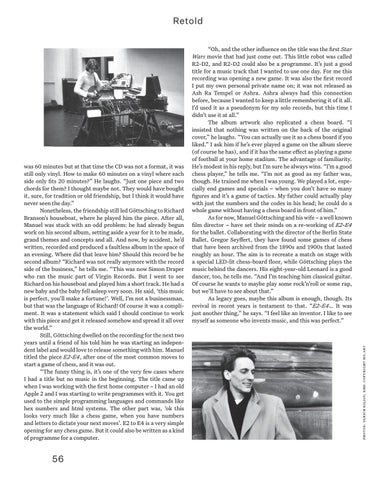Retold
56
photos: ulrich kilian; kmd. copyright mg.art
was 60 minutes but at that time the CD was not a format, it was still only vinyl. How to make 60 minutes on a vinyl where each side only fits 20 minutes?” He laughs. “Just one piece and two chords for them? I thought maybe not. They would have bought it, sure, for tradition or old friendship, but I think it would have never seen the day.” Nonetheless, the friendship still led Göttsching to Richard Branson’s houseboat, where he played him the piece. After all, Manuel was stuck with an odd problem: he had already begun work on his second album, setting aside a year for it to be made, grand themes and concepts and all. And now, by accident, he’d written, recorded and produced a faultless album in the space of an evening. Where did that leave him? Should this record be he second album? “Richard was not really anymore with the record side of the business,” he tells me. “This was now Simon Draper who ran the music part of Virgin Records. But I went to see Richard on his houseboat and played him a short track. He had a new baby and the baby fell asleep very soon. He said, ‘this music is perfect, you’ll make a fortune!’. Well, I’m not a businessman, but that was the language of Richard! Of course it was a compliment. It was a statement which said I should continue to work with this piece and get it released somehow and spread it all over the world.” Still, Göttsching dwelled on the recording for the next two years until a friend of his told him he was starting an independent label and would love to release something with him. Manuel titled the piece E2-E4, after one of the most common moves to start a game of chess, and it was out. “The funny thing is, it’s one of the very few cases where I had a title but no music in the beginning. The title came up when I was working with the first home computer – I had an old Apple 2 and I was starting to write programmes with it. You get used to the simple programming languages and commands like hex numbers and html systems. The other part was, ‘ok this looks very much like a chess game, when you have numbers and letters to dictate your next moves’. E2 to E4 is a very simple opening for any chess game. But it could also be written as a kind of programme for a computer.
“Oh, and the other influence on the title was the first Star Wars movie that had just come out. This little robot was called R2-D2, and R2-D2 could also be a programme. It’s just a good title for a music track that I wanted to use one day. For me this recording was opening a new game. It was also the first record I put my own personal private name on; it was not released as Ash Ra Tempel or Ashra. Ashra always had this connection before, because I wanted to keep a little remembering it of it all. I’d used it as a pseudonym for my solo records, but this time I didn’t use it at all.” The album artwork also replicated a chess board. “I insisted that nothing was written on the back of the original cover,” he laughs. “You can actually use it as a chess board if you liked.” I ask him if he’s ever played a game on the album sleeve (of course he has), and if it has the same effect as playing a game of football at your home stadium. The advantage of familiarity. He’s modest in his reply, but I’m sure he always wins. “I’m a good chess player,” he tells me. “I’m not as good as my father was, though. He trained me when I was young. We played a lot, especially end games and specials – when you don’t have so many figures and it’s a game of tactics. My father could actually play with just the numbers and the codes in his head; he could do a whole game without having a chess board in front of him.” As for now, Manuel Göttsching and his wife – a well known film director – have set their minds on a re-working of E2-E4 for the ballet. Collaborating with the director of the Berlin State Ballet, Gregor Seyffert, they have found some games of chess that have been archived from the 1890s and 1900s that lasted roughly an hour. The aim is to recreate a match on stage with a special LED-lit chess-board floor, while Göttsching plays the music behind the dancers. His eight-year-old Leonard is a good dancer, too, he tells me. “And I’m teaching him classical guitar. Of course he wants to maybe play some rock’n’roll or some rap, but we’ll have to see about that.” As legacy goes, maybe this album is enough, though. Its revival in recent years is testament to that. “E2-E4… It was just another thing,” he says. “I feel like an inventor. I like to see myself as someone who invents music, and this was perfect.”

